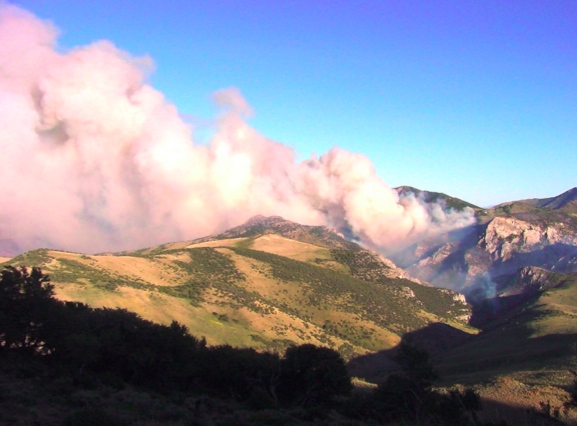With fire season about half over Nevada and federal are keeping their fingers crossed that the Silver State’s luck will hold out until autumn’s rains.
“So far we have not had a major wild fire,” said Rex McKnight Nevada Fire Management Officer for the Bureau of Land Management. “A lot of that has to do with weather. There has not been much dry lightening for instance so far this year.”
In addition to luck the dearth of wildfires not only this year but through the past several years may also be due to a change in land management philosophy.
In the wake of devastating wild fires in the late 1990’s and early 2000’s the BLM as well as state forestry and wildlife divisions began an aggressive program of proscribed burns. While occasionally those burns became wild fires in their own right, the program of intentionally burning sections of forests and wild land with a high accumulation of deadwood may be paying off.
In addition the Living With Fire Program has been credited with changing the philosophy of fire prevention from hoping for the best to planning for and preventing the worst.
 “Living With Fire is an inter-agency program coordinated and implemented by University of Nevada Cooperative Extension (UNCE) that teaches Nevadans how to live more safely in wildfire prone areas. Started in 1998 by UNCE specialists, on-campus researchers and Nevada’s firefighting agencies, LWF has grown from a local, western Nevada effort to national prominence.” said LWF Director Sonya Sistare. “Living With Fire accomplishes its educational mission through a variety of delivery methods including publications, curricula materials, classes, conferences, television and radio programs, websites, social media, public service announcements and by other means. With wildfire as a natural part of Nevada’s ecology, for communities situated in wildfire-prone areas, it’s not a matter of if but when a wildfire will threaten. Residents of these communities can learn how to reduce the wildfire threat by going to LivingWithFire.info.”
“Living With Fire is an inter-agency program coordinated and implemented by University of Nevada Cooperative Extension (UNCE) that teaches Nevadans how to live more safely in wildfire prone areas. Started in 1998 by UNCE specialists, on-campus researchers and Nevada’s firefighting agencies, LWF has grown from a local, western Nevada effort to national prominence.” said LWF Director Sonya Sistare. “Living With Fire accomplishes its educational mission through a variety of delivery methods including publications, curricula materials, classes, conferences, television and radio programs, websites, social media, public service announcements and by other means. With wildfire as a natural part of Nevada’s ecology, for communities situated in wildfire-prone areas, it’s not a matter of if but when a wildfire will threaten. Residents of these communities can learn how to reduce the wildfire threat by going to LivingWithFire.info.”
“We are not predicting whether we will have a bad fire season or a light fire season,” said Sistare. “We know we will have wild fires and we need to educate people on how to cope.”
Sistare’s comments were echoed by Bureau of Land Management’s Public information officer Chris Hanefield.
 “You can make some guesses regarding the amount of fuel and the rainfall in the winter and spring but the only way to tell how bad fire season is when its here. The conditions can change so rapidly that forecasts made in February or March may have no bearing on what June July or august will be like. We know there will be fires and we have to be prepared.”
“You can make some guesses regarding the amount of fuel and the rainfall in the winter and spring but the only way to tell how bad fire season is when its here. The conditions can change so rapidly that forecasts made in February or March may have no bearing on what June July or august will be like. We know there will be fires and we have to be prepared.”
The reason for the hesitancy to make a prediction could be because the chief cause of Nevada wild fires are thunder clouds that produce lightening but little if any rain as they sweep across the high desert in the summer.
And as the season turns to July there are indications that Nevada’s luck my not be holding.
As late as Wednesday afternoon Hanefield report three smal fires burning.
“Firefighters this evening are suppressing three lightning-ignited, wind-driven wildfires in Lincoln and White Pine counties. Public and firefighter safety is the top priority.” Hanefeild wrote in a press release.
“The Middle Ridge Fire, which is burning in scattered pinion-juniper and sagebrush about five miles south of Beaver Dam State Park in eastern Lincoln County, is estimated to be 500-plus acres. No structures are threatened. On-scene is one Type 3 helicopter, two engines and a team of smokejumpers. The fire was first reported at about 7:30 p.m., yesterday (Tuesday, July 1.)
The Dots Fire, burning in pinion-juniper and sagebrush about a mile and a-half southwest of Beaver Dam State Park, is also estimated to be 500-plus acres. The park is not threatened at this time. The Lincoln County Fire Protection District is, however, providing structure protection to several isolated structures in the fire’s path. A Type 3 helicopter, three engines, a water tender and team of smokejumpers are currently engaged in suppression efforts. The fire was first reported at about 10 a.m., today (Wednesday, July 2).
 The estimated 800-plus acre Lages Fire is located near Lages Junction, about 50 miles north of Ely, in White Pine County. The fire that was first reported at about 1 p.m., today (Wednesday, July 2) is burning in critical sage-grouse habitat, consuming sagebrush and isolated pinion-juniper. No structures are threatened though U.S. Highway 93 was temporarily closed this afternoon for public safety (smoke). One Type 3 helicopter, five engines and water tender are engaged on the fire. The BLM Ely District is being assisted by the White Pine County Fire Protection District.
The estimated 800-plus acre Lages Fire is located near Lages Junction, about 50 miles north of Ely, in White Pine County. The fire that was first reported at about 1 p.m., today (Wednesday, July 2) is burning in critical sage-grouse habitat, consuming sagebrush and isolated pinion-juniper. No structures are threatened though U.S. Highway 93 was temporarily closed this afternoon for public safety (smoke). One Type 3 helicopter, five engines and water tender are engaged on the fire. The BLM Ely District is being assisted by the White Pine County Fire Protection District.
Additional resources are en route to all three fires.” he concluded.
A summer full of dry lightening clouds will have many more wild fires than one with fewer but whether summer clouds bear rain or lightening depends on that particular day when the cloud is overhead.
Another consideration is where the lightening hits. In a field of sage brush the strike could be relatively mild however a strike in over grown forest or worst yet in an area dominated by the invasive cheat grass a lightening strike could be the catalyst for an inferno that could claim hundreds of thousands of acres in less than a week.
 Cheat grass is the generic name for several types of annual brome grasses. The most common type, downy brome is most prevalent in Idaho, Nevada and Utah. For the past 150 years it has been waging a war of conquest and it is winning.
Cheat grass is the generic name for several types of annual brome grasses. The most common type, downy brome is most prevalent in Idaho, Nevada and Utah. For the past 150 years it has been waging a war of conquest and it is winning.
From its lowly beginning as cheap packing material it now infests more than 100 million acres of land in the western United States making it the most abundant invasive species in the nation and is quickly replacing sage brush as the dominant plant in the Great Basin.
While its reproduction is prestigious the true secret to its success is the exploitation of fire. Cheat grass conquers with fire, it grows and germinates up to two months before most native grass and once it establishes a foothold, it dies leaving tender dry stalks ready to ignite.
And when it burns, it all burns. Wildfires in cheat grass can travel over 30 miles an hour and the scorch earth left behind is perfect new territory for the next cheat grass.
And sagebrush the dominant plant in the Great Basin acre by acre is slowly being replaced.
In the Great Basin, cheat grass has shunted away the native sagebrush steppe and now dominates 25 million acres – roughly one-third of the region.


